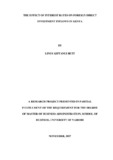| dc.contributor.author | Bett, Linus, K | |
| dc.date.accessioned | 2018-02-02T08:35:58Z | |
| dc.date.available | 2018-02-02T08:35:58Z | |
| dc.date.issued | 2017 | |
| dc.identifier.uri | http://hdl.handle.net/11295/103228 | |
| dc.description.abstract | Interest rates are critical determinants of foreign direct investment. Traditionally, investors will shop for low cost credit sources or lower interest rates and invest it in economies that are promising higher returns. The economic theory which expounds on how capital moves a worldwide economy insist on the fact that capital tends to flow to states which have a return on investment that is higher as compared to countries with higher interest rates. Consequently, investment is high in states that offer better investment returns as well as security in the form of lower interest rates and a better business environment.This study sought to determine the effect of interest rates on foreign direct investments inflows in Kenya. The independent variable was interest rates as measured by quarterly CBK lending rate. The control variables were economic growth as measured by quarterly GDP, exchange rates as measured by quarterly exchange rate between KSH/USD and inflation rates as measured by quarterly CPI. FDI inflows in Kenya were the dependent variable which the study sought to explain and it was measured by FDI inflows in the country on a quarterly basis. Secondary data was collected for a period of 10 years (January 2007 to December 2017) on a quarterly basis. The study employed a descriptive research design and a multiple linear regression model was used to analyze the relationship between the variables. Statistical package for social sciences version 21 was used for data analysis purposes. The results of the study produced R-square value of 0,320 which means that about 32 percent of the variation in FDI inflows in Kenya can be explained by the four selected independent variables while 68 percent in the variation was associated with other factors not covered in this research. The study also found that the independent variables had a strong correlation with FDI inflows (R=0.566). ANOVA results show that the F statistic was significant at 5% level with a p-value less than 0.005. Therefore the model was fit to explain FDI inflows in Kenya. The results further revealed that individually, interest rates, economic growth, exchange rates and inflation rates are not significant determiners of FDI inflows in Kenya. This study recommends that there is need for policy makers to regulate the interest rates prevailing in the country bearing in mind that they influence FDI inflows in the country. | en_US |
| dc.language.iso | en | en_US |
| dc.publisher | University of Nairobi | en_US |
| dc.rights | Attribution-NonCommercial-NoDerivs 3.0 United States | * |
| dc.rights.uri | http://creativecommons.org/licenses/by-nc-nd/3.0/us/ | * |
| dc.subject | The Effect of Interest Rates on Foreign Direct Investment Inflows in Kenya | en_US |
| dc.title | The Effect of Interest Rates on Foreign Direct Investment Inflows in Kenya | en_US |
| dc.type | Thesis | en_US |



